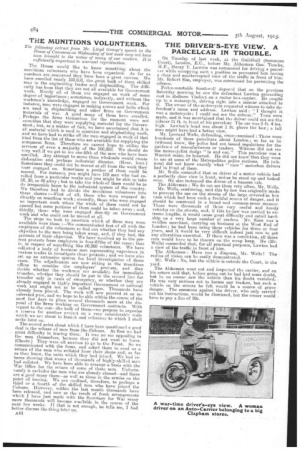THE DRIVER'S-EYE VIEW. A PARCELCAR IN TROUBLE.
Page 14

If you've noticed an error in this article please click here to report it so we can fix it.
On Tuesday of last week, at the Guildhall (Summons Court), London, E.C., before Mr. Alderman Geo. 'Touche,
M.P., Henry T. Lawton was summoned for driving a parcelear while occupying such a position as prevented him having a clear and uninterrupted view of the traffic in front of him. Mr. Hobert Sim, employer, was summoned for permitting the offence.
Police-constable Southwell deposed that on the previous Saturday morning he saw the defendant Lawton proceeding east in Holborn Viaduct on a motor box-carrier. He caught up to a motorcycle, driving right into a sidecar attached to it. The owner of the motorcycle requested witne.sa to take de fendant's name and address. Lawton said : "I thought it was a motorcycle; I could not see the sidecar." Tests were made, and it was ascertained that the driver could not zee the sidecar 11 ft in front of his pareelcar. The car was 3 ft. 4 ins. high. Lawton's head was about 1 ft. above the box ; a tall man might have had a better view, Mr. Leonard Wells, defending, cress-examined There were:
hundreds of these pan-clears about London • so far as he (witness) knew, the police had not issued regulations for the
guidance of manufacturers or traders. Witness did not see the motorcyclist dodge " in and out." This parcelcar was a Warrick make, he believed. He did not know that they were in use at some of the Metropolitan police stations. He (witneas) did not know exactly what " view " motorbus drivers had in front of them.
Mr. 'Wells contended that no driver of a motor vehicle had a perfectly clear view in front, unless he stood up and looked over. He also instanced the driver cf a hansom cab.
The Alderman : We do not see them very often, Mr. Wells. Mr. Wells, continuing, said this by-law was originally made to prevent the use on the streets of the large covered-in box vans which had been such a fruitful source of danger, and it should be construed in a broad and common-sense manner. There were thousands of these very useful and handy vehicles on the streets, and, if this by-law was carried to ex treme lengths, it would cause great difficulty and entail hard. ship on a very large number of traders. Mr. Sims was a wcollen merchant, carrying on business at the West End of London; he had been using these vehicles for three or four years, and it would be very difficult indeed juat now to get any alterations executed. If there was a conviction, all these ears would have to be thrown on the scrap heap. He (Mr. Wells) contended that, for all practical purposes, Lawton had a view of the traffic in front of him.
The Alderman : Have you a diagram, Mr. Wells? The • radius of vision can be easily demonstrated. Mr. Wells : No, but the vehicle is outside the Court, in the yard. The Alderman went out and inspected the carrier, and on his return said that, before going out he had had some doubt, but he no sooner saw the vehicle than his doubt vanished. He was very anxious not to harass any traders, but such a vehicle on the streets he felt would be a source of grave • danger. The summons against the driver, who only carried -out his instructions, would be dismissed, but the owner would have to pay a fine of 20s.




















